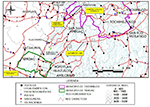Colonialism, marginalization and permanence of the huauhtli in Morelos and Puebla, Mexico
DOI:
https://doi.org/10.15381/espiral.v2i3.18448Keywords:
huauhtli, alegría, amaranth, Indigenous People, peasant, colonialismAbstract
The huauhtli was domesticated by the native peoples of central Mexico, and between 1500 and 900 B.C., its cultivation was already widespread among the people of the region. This plant is included as a historical food heritage in rural localities in eastern Morelos, in Huazulco and Amilcingo, municipality of Temoac, in the Amatzinac Ravine (Barranca del Amatzinac) region; and also, in the small cities on the slopes south of the Popocatépetl volcano, belonging to the municipality of Tochimilco and Atzitzihuacán. The pueblos of Morelos, in addition to cultivating the huauhtli, are specialized in the elaboration of products based on amaranth. In the communities of the volcano this plant is cultivated since ancient times, and today they are the main producers nationwide. These peoples protected the varieties of huauhtli, even in disastrous conditions, such as the loss of irrigation water, through the use of ancestral memory, agriculture, religiosity and identity, which is observed in the calendrical religious times. Since 2008, field work has been carried out in the region, mainly visits, tours, participation in community and government events, and semi-structured interviews with farmers, workshop members, authorities and organizations. The permanence of the uses of huauhtli as the main economic activity is shown, both in the elaboration of products in Morelos and in the sale of seeds in Puebla. Amaranth remained in these populations with community ties, resisting food colonialism, colonial contempt, republican oblivion and capitalist insolence.

Downloads
Published
Issue
Section
License
Copyright (c) 2020 Rodrigo Meiners Mandujano

This work is licensed under a Creative Commons Attribution-NonCommercial-ShareAlike 4.0 International License.
LOS AUTORES RETIENEN SUS DERECHOS:
a. Los autores retienen sus derechos de marca y patente, y también sobre cualquier proceso o procedimiento descrito en el artículo.
b. Los autores retienen el derecho de compartir, copiar, distribuir, ejecutar y comunicar públicamente el artículo publicado en la revista Espiral (por ejemplo, colocarlo en un repositorio institucional o publicarlo en un libro), con un reconocimiento de su publicación inicial en la revista Espiral.
c. Los autores retienen el derecho a hacer una posterior publicación de su trabajo, de utilizar el artículo o cualquier parte de aquel (por ejemplo: una compilación de sus trabajos, notas para conferencias, tesis, o para un libro), siempre que indiquen la fuente de publicación (autores del trabajo, revista, volumen, número y fecha).





